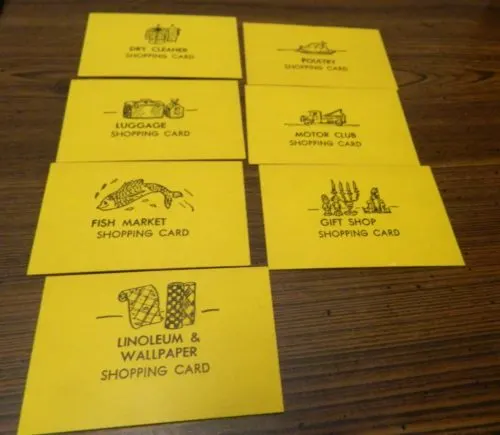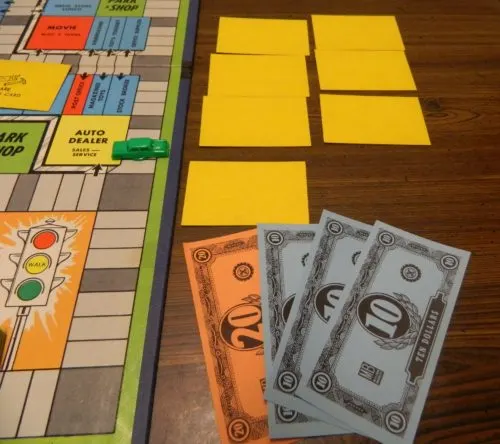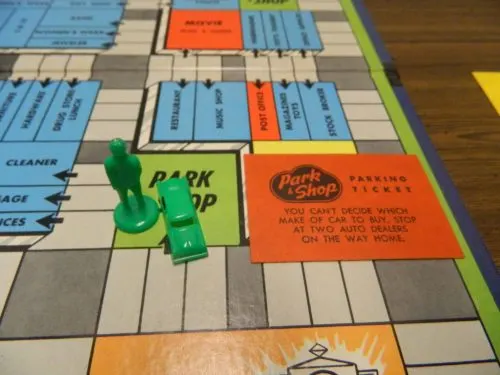Over the years board games have been made on a lot of different topics. From fantastic adventures in other worlds to simulating wars and the stock market, most board games are used as escapes that simulate things most people will never be able to experience in their own lives. Then there are the occasional board games that simulates every day events like shopping. There have been a couple shopping games made in the past which include games like Electronic Mall Madness and the game I am looking at today, Park and Shop. While shopping might not seem like the best theme for a board game, I think it has the potential for a good board game. While Park and Shop had a lot of potential for its’ time, this is one shopping experience that you are better off staying away from.
How to Play
Setup
Separate the red parking tickets from the red motorist cards. Shuffle both of these decks along with the green cards and place them on their corresponding spots on the gameboard. Shuffle the yellow cards and deal out the chosen number of shopping cards for the game (the game recommends 3-7) to each player.

Here is the shopping list for one of the players. This player has to visit the dry cleaner, poultry, luggage, motor club, fish market, gift shop and the linoleum and wallpaper stores.
Each player takes a matching car, pedestrian, and chip. The players roll the dice to determine who gets to play first. The first player is also the first to choose their house space on the outer ring of the board. Each player marks the location of their house with their chip.
Playing the Game
To begin the game every player starts at their chosen house in their car. Each player rolls one die on their turn as they move their car towards one of the Park and Shop spaces. When a player reaches one of the spaces they park their car and draw a parking ticket card which indicates an action you have to perform before going home.
Players then get out of their car and begin using their pedestrian piece. While using your pedestrian piece you get to roll both dice. If you roll doubles you get another turn and if you roll doubles three times in a row you go to jail. When moving you cannot turn around during a turn but you can turn around between turns.
While moving around the gameboard you may have to draw additional cards if you land on an intersection space (darker gray spaces). When you land on an intersection while driving you have to draw a motorist card. If you land on one while you are a pedestrian you draw a pedestrian card. If the card gives you another stop you must complete it sometime before you go home.

The green pedestrian and the yellow car stopped at intersections. The green player will have to draw a pedestrian card. The yellow player will have to draw a motorist card.
If two players ever land on the same space, both players on the space lose their next turn.
If a player stops on the extra turn space, they will immediately take another turn.

The red player has landed on the extra turn space so they are able to immediately take another turn.
When you reach a shop (doesn’t have to be by exact count) indicated on one of your shopping cards, your turn ends. You flip over the shopping card for that store to indicate that you have completed that task.

The white player has reached the luggage store so they are able to turn over their luggage shopping list card.
Winning the Game
When a player has completed all of their cards, they walk back to their car and get in. At this point players only get to roll one die. Once in their car each player will handle the task on their parking ticket. After handling their parking ticket they head home. The first player to arrive home by exact count wins the game.

The green player has completed all of their cards and was the first player to arrive home. The green player has won the game.
Playing With Money
Park and Shop has alternate rules which allow you to play the game with money. The game for the most part is played the same way but players have to pay for items and other things that you would pay for in real life. When playing with money all players are given $150 at the beginning of the game. When a player enters a store to purchase items they roll both dice and pay the amount of money rolled.
If you have to pay for something due to a pedestrian, motorist or parking ticket card you roll one die to determine how much you have to pay. If a player ever runs out of money they must head home without completing all of their errands.
When a player arrives home, each player calculates their score as follows:
- If a player completes all of their shopping and is the first player to get home, they receive ten points.
- All cards that a player has completed are worth five points.
- Any uncompleted shopping cards are worth negative three points.
- Players receive one point for every $10 that they have remaining.
After everyone has calculated their score, the player with the highest score wins the game.

This player has scored either 40 or 50 points based on if they were the first player to arrive home to earn the additional ten points. The player would score 35 points for the cards (7 cards * 5 points), and five points for the money ($50/10).
Review
Looking into the backstory behind the creation of Park and Shop reveals a pretty interesting history for the game. Apparently Park and Shop was originally created in 1952 as a tool to illustrate to residents of Allentown, Pennsylvania the concept of the parking lots that were recently added to the town. You don’t really see backstories like that for games created today.
What initially drew me to Park and Shop is that I have been looking for a good shopping themed board game. I don’t know why but I think the concept of shopping could make for a good board game. Before I played Park and Shop I was hoping it could be that game. Park and Shop actually showed a lot of potential but due to some poor design choices it just doesn’t work that well as a game.
While the game has an interesting concept, the game fails to do much with it. Basically Park and Shop boils down to a roll and move game. Roll the dice and move the corresponding number of spaces as you try to get to the stores that have the items that you are looking for. If this didn’t add enough luck to the game there is the card draw luck. Between the rolling of the dice and the ability to draw shopping cards for a bunch of stores that are close to one another, luck basically decides who will win the game. While you can use a little strategy to plan your route between the different stores to save some time, these decisions are usually so obvious that you really can’t gain an advantage on another player based on your strategy.
One area that Park and Shop had some potential is with the fact that players control both a pedestrian and a car. The fact that you have to park your car and then walk to the different stores is an interesting idea especially for a 1960s roll and move game. The problem is that this mechanic is wasted in my opinion. While the game tries to explain why you get to roll both dice while walking instead of driving your car (you have two feet versus one engine in your car) this really doesn’t make any sense thematically or gameplay wise. If a person could walk faster than they could drive, why would you ever drive your car. Since you can walk faster you would be better off in the game just walking from your house to the stores and then back to your house since you could move faster and wouldn’t have to worry about parking and getting back into your car. The game was designed to feature parking lots but the mechanic just doesn’t make a lot of sense for a board game.
The main reason I don’t like this mechanic is that if they just reversed it I think it would have made for a much better game. If you got to roll two dice while driving and only one while walking it would open up some interesting mechanics for the game. For example, since you could move faster in your car you could consider getting back into your car and driving to the other side of the board if there was a lot of spaces between stores you had to visit. While this wouldn’t have completely fixed the game I think it would have added a little strategy to the game as players decided whether they wanted to waste the time going back to their car in order to move quicker or if they would just walk to the next store.
Another missed opportunity in the game is how money is handled. First I would highly recommend playing the game with the money rules because it might not significantly change the game but it does make it a little better. The problem with the money mechanic in the game is that it is basically worthless since the game gives you way too much money to start the game. Basically everyone in the game that I played didn’t even use half of their money. Unless you have terrible luck there is no need to worry about running out of money. That is disappointing since I think the idea of being able to run out of money is an interesting idea and the game could have implemented a way in order to make additional money in order to continue shopping. As a whole the money doesn’t really play a big role in determining the winner since a player will likely only get one or two additional points if they are able to spend less money than another player. With the money rules the first player to get home will win at least 90% of the time.
The final problem that I had with the game is that it is too short. Unless you get cards from all over the board, you seem to finish shopping as quickly as you begin. We ended up playing with five cards (right in the middle of the recommended amount) and the game was so short. Playing with two additional cards really wouldn’t have added much to the game. While the game is about the right length at around 20-30 minutes, it just doesn’t feel like much happens in the game. If you had to do more in the game it would likely reduce the amount of luck and might actually add a little strategy to the game.
These are just three examples of the wasted opportunities in Park and Shop. Park and Shop has the potential to be a good game but it just doesn’t live up to that potential. I think it would be interesting trying to create some house rules for Park and Shop though since the game has potential. With the right house rules I think Park and Shop could be a pretty good roll and move game.
Growing up in the late 1980s and 1990s, it is always interesting playing games from the 1960s to see how things have changed in board games. Park and Shop feels outdated at times but also kind of feels like a time capsule for the 1960s at the same time. It is pretty interesting looking at the different stores that you would never see today. Then there is the “subtle” sexism that was in a surprising large amount of 1960s games with the motorist card in Park and Shop “There’s a woman driver in front of you. Lose one turn.”
Speaking of the old school feel of the game, for a Milton Bradley game Park and Shop actually had some pretty good components for a 1960s game. The car and passenger tokens are pretty cool and some versions of the game actually had metal pieces instead of the plastic pawns included with my copy of the game. The game’s artwork is kind of on the bland side but this is the type of older board game that collectors of board games will probably really appreciate.
Final Verdict
Before playing Park and Shop I thought the game had potential. I thought the idea of being able to go around town shopping had some potential. The problem is the game’s mechanics kind of ruin that potential. For example the idea that you walk faster than you drive ruins the potential mechanic of getting in and out of your car in order to drive around town quicker. Due to the game wasting its’ opportunities, the game ends up relying almost entirely on the luck of the roll and draw of the cards since strategy will rarely impact the game.
Park and Shop has a lot of problems so I have a hard time recommending the game. If you don’t really like roll and move games or don’t want to create a lot of house rules, Park and Shop is not going to be for you. If you like old roll and move games and are willing to make some house rules or you have fond memories of the game it may be worth picking up if you find it for cheap.
If you would like to purchase Park and Shop you can find it on Amazon.





Nancy W Kahumoku
Tuesday 5th of May 2020
I played this game as a child with my father and older brother (without the money). We used 8 cards and dad added more shaded spots on the board with a magic marker where we inconveniently acquired more out-of-the-way errands to make the game longer. As an adult, the skills I acquired as a child in placing my errands in the best order for getting home fastest, are used all the time. I even worked as a personal shopper for a number of years. Of course, Iʻd often get a call that would add an inconvenient item to my logically ordered shopping list! I fondly remembered Park and Shop every single day. Itʻs the only game I kept from my childhood. I still have it in a place of honor 50 years later. Thanks for the rules review here. I had forgotten some of the rules.